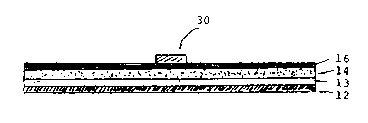Some of the information on this Web page has been provided by external sources. The Government of Canada is not responsible for the accuracy, reliability or currency of the information supplied by external sources. Users wishing to rely upon this information should consult directly with the source of the information. Content provided by external sources is not subject to official languages, privacy and accessibility requirements.
Any discrepancies in the text and image of the Claims and Abstract are due to differing posting times. Text of the Claims and Abstract are posted:
| (12) Patent Application: | (11) CA 2469582 |
|---|---|
| (54) English Title: | CLEANING PAD FOR SINGLE-DISK OR MULTI-DISK CLEANING MACHINES |
| (54) French Title: | TAMPON NETTOYEUR POUR MACHINES DE NETTOYAGE MONODISQUE OU POLYDISQUE |
| Status: | Deemed Abandoned and Beyond the Period of Reinstatement - Pending Response to Notice of Disregarded Communication |
| (51) International Patent Classification (IPC): |
|
|---|---|
| (72) Inventors : |
|
| (73) Owners : |
|
| (71) Applicants : |
|
| (74) Agent: | GOWLING WLG (CANADA) LLP |
| (74) Associate agent: | |
| (45) Issued: | |
| (86) PCT Filing Date: | 2003-11-16 |
| (87) Open to Public Inspection: | 2004-06-03 |
| Availability of licence: | N/A |
| Dedicated to the Public: | N/A |
| (25) Language of filing: | English |
| Patent Cooperation Treaty (PCT): | Yes |
|---|---|
| (86) PCT Filing Number: | PCT/EP2003/012798 |
| (87) International Publication Number: | WO 2004045359 |
| (85) National Entry: | 2004-06-21 |
| (30) Application Priority Data: | ||||||
|---|---|---|---|---|---|---|
|
The invention relates to a cleaning pad for single-disk and multi-disk
cleaning machines, comprising an outer textile pad and a holding element for
holding the cleaning pad on the cleaning machine. Said cleaning pad (10)
consists of at least four layers. At least one absorbent layer (13) is
arranged on the textile pad used as a working pad (12), and a regenerative
core layer (14) is then applied to the absorbent layer, followed by a covering
layer (16).
L'invention concerne un tampon nettoyeur conçu pour des machines de nettoyage monodisque ou polydisque, comprenant un tampon textile extérieur ainsi qu'un élément de maintien qui sert à maintenir le tampon nettoyeur sur la machine de nettoyage. Selon l'invention, le tampon nettoyeur (10) est constitué d'au moins quatre couches. Au moins une couche absorbante (13) est disposée sur le tampon textile qui sert de tampon de travail (12), et une couche centrale de régénération (14) puis une couche de recouvrement (16) sont disposées sur cette couche absorbante.
Note: Claims are shown in the official language in which they were submitted.
Note: Descriptions are shown in the official language in which they were submitted.

2024-08-01:As part of the Next Generation Patents (NGP) transition, the Canadian Patents Database (CPD) now contains a more detailed Event History, which replicates the Event Log of our new back-office solution.
Please note that "Inactive:" events refers to events no longer in use in our new back-office solution.
For a clearer understanding of the status of the application/patent presented on this page, the site Disclaimer , as well as the definitions for Patent , Event History , Maintenance Fee and Payment History should be consulted.
| Description | Date |
|---|---|
| Time Limit for Reversal Expired | 2009-11-16 |
| Application Not Reinstated by Deadline | 2009-11-16 |
| Inactive: Abandon-RFE+Late fee unpaid-Correspondence sent | 2008-11-17 |
| Deemed Abandoned - Failure to Respond to Maintenance Fee Notice | 2008-11-17 |
| Small Entity Declaration Determined Compliant | 2007-11-16 |
| Inactive: IPC from MCD | 2006-03-12 |
| Inactive: IPC from MCD | 2006-03-12 |
| Letter Sent | 2005-07-18 |
| Inactive: Correspondence - Transfer | 2005-06-28 |
| Inactive: Single transfer | 2005-06-16 |
| Inactive: Cover page published | 2004-09-01 |
| Inactive: Courtesy letter - Evidence | 2004-08-31 |
| Inactive: Notice - National entry - No RFE | 2004-08-30 |
| Inactive: Inventor deleted | 2004-08-30 |
| Amendment Received - Voluntary Amendment | 2004-08-19 |
| Application Received - PCT | 2004-07-08 |
| National Entry Requirements Determined Compliant | 2004-06-21 |
| National Entry Requirements Determined Compliant | 2004-06-21 |
| Application Published (Open to Public Inspection) | 2004-06-03 |
| Abandonment Date | Reason | Reinstatement Date |
|---|---|---|
| 2008-11-17 |
The last payment was received on 2007-11-16
Note : If the full payment has not been received on or before the date indicated, a further fee may be required which may be one of the following
Please refer to the CIPO Patent Fees web page to see all current fee amounts.
| Fee Type | Anniversary Year | Due Date | Paid Date |
|---|---|---|---|
| Basic national fee - small | 2004-06-21 | ||
| Registration of a document | 2004-06-21 | ||
| MF (application, 2nd anniv.) - small | 02 | 2005-11-16 | 2005-11-02 |
| MF (application, 3rd anniv.) - small | 03 | 2006-11-16 | 2006-11-16 |
| MF (application, 4th anniv.) - small | 04 | 2007-11-16 | 2007-11-16 |
Note: Records showing the ownership history in alphabetical order.
| Current Owners on Record |
|---|
| JOHANN RITTGASSER |
| Past Owners on Record |
|---|
| DETLEF RAUH |